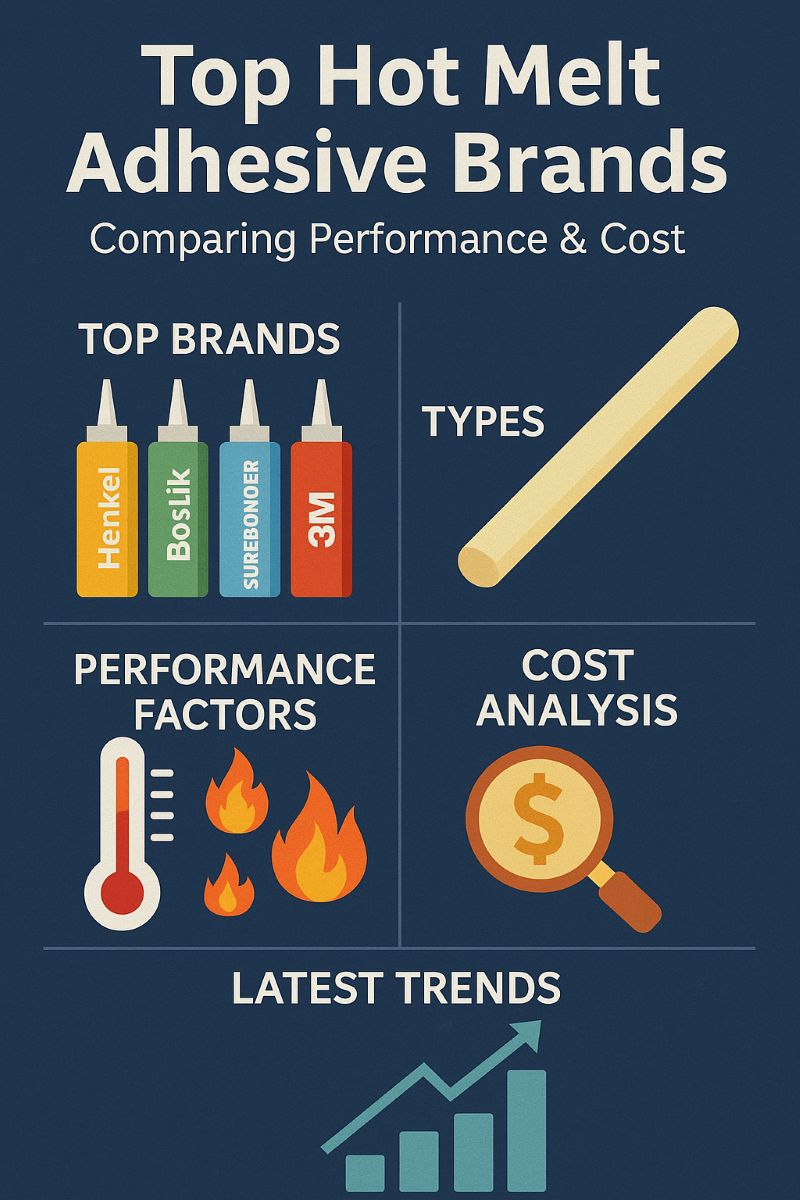
Top Brand Landscape
Hot Melt Adhesive Definition
Types of Hot Melt Adhesives
Performance Factors
Cost Analysis of Suppliers
Latest Trends in Adhesives
Strategies for Cost Efficiency
Frequently Asked Questions (FAQ)
The hot melt adhesive market features a dynamic range of global suppliers known for delivering a balance of performance and cost-efficiency. Some companies emphasize versatility across applications, while others lead with temperature-resistant or sustainability-focused solutions. Industry leaders typically offer specialized adhesive technologies, catering to packaging, construction, electronics, and other sectors. By understanding each supplier’s core strengths—whether it's innovation, affordability, or eco-friendliness—businesses can align with partners that best suit their operational goals.
Hot melt adhesives are solid thermoplastic bonding agents that become tacky when heated and solidify quickly upon cooling. This property enables fast and reliable assembly in automated production lines. These adhesives are valued for their strong bonding performance, minimal curing time, and clean application. Today’s market includes a variety of hot melt technologies, each developed to suit specific environmental conditions and material substrates. Choosing the right adhesive ensures a balance of durability, process efficiency, and cost control.
Hot melt adhesives can be categorized based on their resin base and application purpose:
Ethylene-vinyl acetate (EVA): Offers flexibility and cost-effectiveness for general packaging and bookbinding.
Polyolefin: Delivers moisture resistance and improved adhesion on low-surface-energy substrates.
Polyurethane (PUR): Provides superior strength and chemical resistance for demanding applications.
Pressure-sensitive adhesives (PSA): Remain tacky at room temperature and are widely used in labels and tapes.
Suppliers typically offer a full range of these formulations to meet varying technical and budgetary requirements.
Evaluating hot melt adhesives involves considering key performance criteria:
Bonding Strength: Must match the stress conditions of the application.
Curing Speed: Impacts productivity and cycle time.
Temperature Resistance: Essential for environments with thermal variation.
Material Compatibility: Affects long-term durability and adhesion quality.
Some suppliers focus on rapid-setting adhesives, while others optimize for high-temperature resilience or environmental safety. Understanding these performance traits ensures the adhesive supports both product quality and production efficiency.
Cost comparisons across hot melt adhesive providers should account for more than just price per kilogram. Considerations include:
Performance Longevity: High-performance adhesives may reduce rework and failure rates.
Application Efficiency: Some adhesives offer better spreadability or lower consumption per unit.
Environmental Compliance: Eco-conscious formulations may yield long-term cost savings through regulatory compliance or reduced emissions.
Packaging and Delivery Options: Bulk supply agreements and logistics reliability can significantly affect the total cost of ownership.
Suppliers vary in their approach, from premium-grade industrial products to affordable, high-volume solutions.
The hot melt adhesive sector is rapidly evolving in response to industry demands:
Sustainability: Growing adoption of biodegradable and low-VOC adhesives.
Advanced Formulations: Development of faster-curing, high-strength bonds for extreme environments.
Automation-Friendly Solutions: Optimized adhesives for robotic application and precision dispensing.
Custom Blends: Tailored formulas to meet niche requirements in electronics, automotive, and medical industries.
These trends reflect a shift toward adhesives that are smarter, greener, and more efficient across the product lifecycle.
Businesses can improve cost efficiency with strategic adhesive selection:
Bulk Procurement: Long-term agreements often yield volume-based discounts.
Application-Specific Matching: Using the right adhesive type minimizes waste and optimizes output.
Process Optimization: Investing in automated application tools can reduce human error and material overuse.
Supplier Collaboration: Working closely with suppliers helps adapt formulations to exact process needs.
Combining procurement tactics with tailored adhesive selection leads to reduced waste, improved throughput, and better return on investment.
What are hot melt adhesives?
Hot melt adhesives are thermoplastics that soften when heated and form strong bonds upon cooling, ideal for fast-paced industrial applications.
What types of hot melt adhesives are available?
Common types include EVA, polyolefin, PUR, and pressure-sensitive adhesives—each suited to different environmental and bonding needs.
What performance factors should be considered when selecting an adhesive?
Key factors include strength, curing time, heat resistance, and compatibility with substrates.
How do different suppliers compare on cost and performance?
Some offer high-end adhesives optimized for durability, while others focus on affordable, general-purpose options. Cost-effectiveness depends on application needs.
What trends are shaping the adhesive industry?
Current trends include sustainable formulations, temperature-resistant technologies, and solutions designed for precision automation.
How can businesses reduce adhesive-related costs?
Strategies include buying in bulk, matching adhesive types to specific tasks, and improving application efficiency through automation or training.
Which suppliers are known for sustainability in adhesives?
Many leading suppliers now emphasize eco-friendly adhesives with lower VOCs and recyclable packaging, contributing to greener manufacturing practices.
What industries commonly use hot melt adhesives?
These adhesives are widely used in packaging, automotive, woodworking, construction, consumer goods, and textiles.